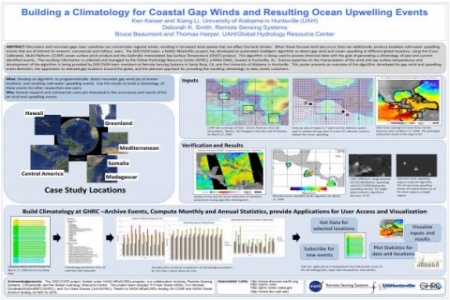Mountains and mountain gaps near coastlines can concentrate regional winds, resulting in increased wind speeds that can affect the local climate. When these focused wind jets occur, they can additionally produce localized cold-water upwelling events that are of interest to research, commercial and military users. The DISCOVER team, a NASA/ MEaSUREs project, has developed an automated intelligent algorithm to detect gap wind and ocean upwelling at different global locations, using the Cross-Calibrated, Multi-Platform (CCMP) ocean surface wind product and the Optimally Interpolated Sea Surface Temperature (OISST) product. This algorithm is being used to process historical data with the goal of generating a climatology of past and current identified events. The resulting information is collected and managed by the Global Hydrology Resource Center (GHRC), a NASA DAAC, located in Huntsville, AL. Science expertise on the interpretation of the wind and sea surface temperatures and development of the algorithm is being provided by DISCOVER team members at Remote Sensing Systems in Santa Rosa, CA, and the University of Alabama in Huntsville. This poster presents an overview of the algorithm developed for gap wind and upwelling event detection, the application to selected gap locations around the globe, and the planned approach for providing the resulting climatology to data center customers.


